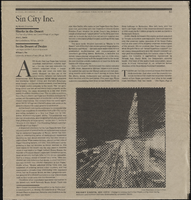Search the Special Collections and Archives Portal
Search Results
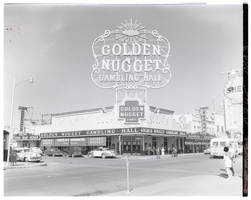
Film transparency of the Golden Nugget Gambling Hall, Las Vegas, Nevada, July, 1949
Date
Archival Collection
Description
Image
Weinberger, William S. "Billy", 1913-1996
William S. "Billy" Weinberger (1913-1996) was president of Caesars Palace in the 1960s and 1970s. He was also president of Bally's Park Place casino in Atlantic City, New Jersey in the 1970s and 1980s and ambassador emeritus for the Golden Nugget and the Mirage in Las Vegas in the 1980s and 1990s.
Person
Weinberger, William S., 1913-1996
William S. "Billy" Weinberger (1913-1996) was president of Caesars Palace in the 1960s and 1970s. He was also president of Bally's Park Place casino in Atlantic City, New Jersey in the 1970s and 1980s and ambassador emeritus for the Golden Nugget and the Mirage in Las Vegas in the 1980s and 1990s.
Person
Brinkerhoff, Donald Carl, 1930-
Don Brinkerhoff of Lifescapes International designed features of Las Vegas casinos such as the Mirage volcano, the Bellagio conservatory, the Wynn Las Vegas mountain, the Encore Casino gardens, and the surroundings of the Welcome to Las Vegas sign on the Las Vegas Strip. He grew up in the southern California suburb of El Monte.
Person
Desert Inn implosion: video
Date
Archival Collection
Description
Moving Image
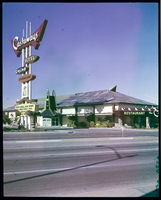
The Castaways Hotel and Casino: photographic film
Date
Archival Collection
Description
Image
Wynn Las Vegas Scrapbook
Identifier
Abstract
The collection consists of one scrapbook (2008) of postcards and photographs tracing the history of the Las Vegas property upon which the Wynn Las Vegas resort was built and four magazines featuring articles about Las Vegas (1940, 1947, 1955, and 1959). The scrapbook begins with several pages of historic postcards of the hotel originally built on the property, the Desert Inn, and continues with the establishment of the Wynn and the vision of its associated resort, the Encore. While the images primarily focus on the Desert Inn and the Wynn, there are also several pages of images of various other Las Vegas Strip properties accompanied by a brief timeline. The scrapbook contains approximately 76 images, dating from 1950 to 2008.
Archival Collection
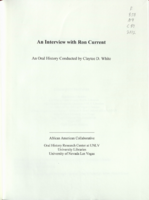
Ron Current interview, March 16, 2012: transcript
Date
Archival Collection
Description
Ron Current's heart was always in the right place, with respect to social activism and his dedication to empowering the black community in Las Vegas. Inspired by Black Panther Party founders, Huey P. Newton and Bobby Seale, Ron started the Black Panther Party Las Vegas Chapter. He was also the director of public relations for the National Alliance Against Racist and Political Repression; an organization created to work in tandem with the National Association for the Advancement of Colored People, NAACP, to eliminate racial inequality. Ron describes the overall atmosphere of the Westside community in Las Vegas during the early days, as chaotic, drug infested, and riddled with daily gang related shootings. He also recalls the historic preservation attempts made by leading members of the Westside community, such as Sarann Knight Preddy. Ron recalls working at the University Medical Center while recruiting for the Black Panther Party Las Vegas Chapter. This interview demonstrates the power of love. As the founder and leader of the Black Panther Party Las Vegas Chapter, Ron was named one of the most influential blacks in Las Vegas by the Sentinel Voice. He recalls utilizing his hands-on leadership approach towards capacity building and the successful implementation of community mobilization strategies and methods. He was a champion for educational equity, equal access to employment opportunities, and economic equality in Las Vegas, Nevada.
Text
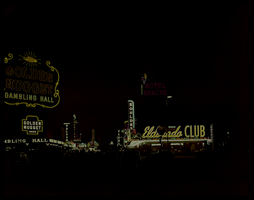
Film transparency of Fremont Street at night, Las Vegas, Nevada, July, 1949
Date
Archival Collection
Description
Image

